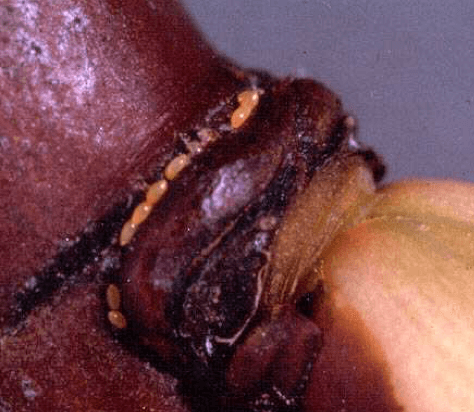Controlling and maintaining low pear psylla populations over the dormant season is critical to controlling this damaging pest of pears. Correctly identifying pear psylla is key in control and preventing damage in your orchard. Applying pesticides at the correct time in the life cycle of the pest you are trying to control is also very important.
Pear psylla overwinter as adults on trees and shrubs adjacent to pear orchards to which they return in early March to begin laying eggs on or near buds.
Growers, both conventional and organic should be scouting their orchards at this time and preparing for Dormant Oil applications.
Below are pictures of the different life stages that a pear psylla will go through:


Pear psylla nymphs have five growth stages, the first three are yellow with red eyes and live within droplets of honeydew. Stage 4 is green with small wing pads and lives freely without honeydew droplets. The fifth stage (hard-shell) is brown to black with distinct wing pads.
Overwintering adults are larger and darker in colour. Adults - Summer adults are greenish to brown in colour with pale wings held roof-like over the 3 mm-long body.
Pest Monitoring:
Monitoring pest and beneficial populations of insects to determine whether or not a pesticide is required is an important aspect in the IPM of pear psylla. Knowing the kind of beneficial organisms in your orchard can help you choose a pesticide that will minimize the damaging effects to these organisms. The BC Tree Fruit Production Guide that lists the relative toxicity of common control products on a variety of common beneficial insects.
Monitoring for pear psylla should be done all year round. There are sampling techniques for the dormant season, at bloom, during the growth season, and during harvest. Different methods for monitoring pear psylla are described below:
- Beating Board Samples
- 3 beats of a branch with a beating stick over a board covered with a light colored fabric
- A hand lens/ magnifying glass may be used to help see if any insects have fallen onto the board.
- Shoot and Spur Samples
- During the dormant season, you can take a two shoot samples from a tree. One from the top, and other from eye level. Each shoot should contain a fruiting spur. Once again, sample at least 5 trees per every 4 acres. Look at each shoot for the presence of pear psylla eggs.
Cultural Control
- Avoid aggressive pruning that will cause trees to become too vigorous (WSU Tree Fruit, Pear IPM Strategies).
- Remove water sprouts from trees. These suckers are the only source of succulent leaves in June for pear psylla (WSU Tree Fruit, Pear IPM Strategies).
- Appropriate N applications. Over applying N can cause trees to have extended growth, and delay hardening off. This provides optimal feeding conditions for Pear Psylla (WSU Tree Fruit, Pear IPM Strategies).
Chemical Control
Dormant to Pink Bud Stage - Apply a dormant spray, up to the pink bud stage - if one or more psylla adults are collected per limb tap in the spring. Dormant oil sprays applied in early March will discourage psylla from laying eggs on pear trees for about 6 weeks until leaves emerge. The addition of lime-sulfur to this early dormant oil treatment can also suppress pear rust mite and pear leaf blister mite.
Resample the orchards at 7-10 days after the dormant oil application. If the average number of psylla per limb tap remains at or above one, apply a second half-rate of oil.
Please refer to the labels of Guardsman Dormant Oil, PureSpray Green Oil and Lime-Sulfur for rates and product application information. Organic growers should check all products with their Certification Bodies prior to use.
Mechanical Control
- The use of reflective plastic mulch has been found to be an effective management tool to aid in the control of pear psylla when used in the early season (research by Louis Nottingham and Betsy Beers, WSU).
- However, the mulch is recommended to be removed partway through the season.
